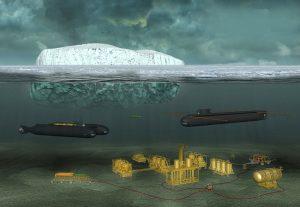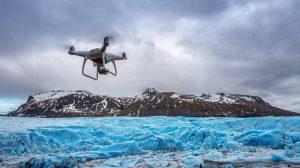
The project of an unmanned underwater station © “The Arctic: present and future”
Domestic enterprises have developed a number of promising projects for unmanned complexes capable of operating effectively in the harsh conditions of the Arctic. Already today, Russia has UAVs that can carry out missions in extreme climatic conditions. Leading scientific institutes are also developing unmanned underwater vehicles capable of conducting seismic exploration and drilling wells.
The Kalashnikov Concern manufactures the Zala Arctic unmanned complex. The device is designed for year-round environmental monitoring. The drone was developed by Zala Aero Group, which holds a leading position in the market of small-sized drones in the Russian Federation.
The UAV is capable of detecting and identifying vessels at a distance of up to 100 km. The Zala Arctic can stay in the air for about four hours and perform tasks at a wind speed of 25 m/s and temperatures up to -50 °C. The peculiarity of this drone is the possibility of using the alternative Girasm navigation system created by Kalashnikov (if there is no GLONASS or GPS signal).
“The biggest problem is the landing of a drone on an Arctic ship. But our equipment has been successfully tested… The temperature environment and weather conditions of the Arctic are not critical for our complexes. Most of our products can be used in high latitudes,” said a representative of the concern.
Air taxis and unmanned helicopters
ADA Aerospace has developed a line of Triada tiltrotor planes with a flight range from 80 to 1.6 thousand km. These devices are capable of being in the air for one to eight hours at temperatures up to -50 ° C. Tiltrotor planes are ideal for exploring the ice situation, searching for wide passages in the ice and transporting goods. The advantages of this device are vertical takeoff and landing. This greatly facilitates the operation of the drone. At the same time, the tiltrotor is inferior in speed to an airplane, and in reliability to a helicopter.

A caravan of ships in the Arctic © RIA Novosti
In the future, tiltrotor planes will be able to transport people over distances of hundreds of kilometers at a low cost of a ticket. In particular, the Triada X model will have such capabilities due to the widespread use of energy-efficient technologies. The tiltrotor will be able to take on board up to five passengers at a time, performing the function of an air taxi.
The largest Russian aerial drone may be a joint project of the Ilyushin Aviation Complex and the Kronstadt Group. The drone is based on the Il-112 light transport aircraft. The Russian Helicopters Holding Company has tested the VRT300 device. It is intended for conducting ice reconnaissance. It is assumed that the drone will be in demand due to the rapid growth of cargo traffic along the Northern Sea Route. The peculiarity of the VRT300 is the use of a Kamov coaxial circuit. It is more expensive than the usual single-screw system, but at the same time it allows you to increase the stability of the device to wind gusts. The maximum take—off weight of the device is 300 kg, the payload weight is 70 kg.
The VRT300 is being developed in two versions. The Arctic type of this UAV (Arctic Supervision) will be equipped with a side-view radar. He will become an indispensable assistant to the crews of icebreakers, ships and drilling platforms. Another version of the VRT300 will be universal. The main task of the device is monitoring and remote sensing of the Earth. This way he will be able to carry out terrain mapping, conduct search operations, prevent emergencies and transport small loads.
“Sarma”, “Shadow” and drilling station
Russian enterprises pay great attention to the development of the direction of uninhabited underwater vehicles (NPA). Currently, drones of the “Harpsichord” and “Juno” families are used in the Arctic. However, they cannot work effectively under ice, as they have a limited battery charge. However, the Sarma marine drone has been developed for seismic exploration. The device will be able to travel 10 thousand km without surfacing. Specialists of the Lazurit CCBMT are working on the project.
However, the domestic design idea went even further. A promising robotic device “Shadow-2” with increased autonomy and variable body geometry has been developed. This drone is a kind of American trimaran type “Sea Hunter” drone. “Shadow-2” is an initiative development of the SPbGMTU and the State Research Institute of the Republic of Tatarstan of the Ministry of Defense of the Russian Federation. Structurally, the Shadow-2 consists of a universal underwater and surface robot, which is a carrier of small-sized drones with seismic sensors, as well as devices capable of sampling and analyzing soil and water samples.
The main task of this device is to conduct seismic exploration. He must confidently cope with strong waves of water and work under the ice. The displacement of the drone will be 169 tons, carrying capacity — 60 tons, autonomy — 88 days, maximum speed on the surface — 26.43 knots (48.9 km / h), surface range at 6 knots (11.1 km / h) — 12.77 thousand miles (20.5 thousand km).
Evgeny Toropov, Chief Designer of the Central Design Bureau of Marine Engineering (CCB MT) Rubin, spoke about his view on the further development of seismic exploration technologies in the Arctic. According to him, the most promising direction is the use of a swarm of NPAs. The drones will be controlled using special containers with sophisticated equipment that are dropped into the sea from a ship or from a Mi-26 helicopter. However, it makes sense to develop a special drone to transport uninhabited vehicles.
One of the key areas of Rubin’s activity is the development of an unmanned underwater drilling complex. Work on the project has been going on for several years. In addition to Rubin, several other institutes take part in them. Currently, there is not a single underwater drilling rig in the world. Russia may become the first owner of a unique offshore drilling technology. The length of the drilling module is 36 m, the operational height is 41.7 m, the width is 13 m, the weight on land is 1.8 thousand tons.
In an interview with RT, Viktor Boyarsky, director of the Museum of the Arctic and Antarctic in 1998-2016, Honorary Polar explorer of Russia, stressed that engineering in Russia is developing in the “right direction.” In his opinion, Russian specialists are striving to solve the fundamental problem of modern underwater and air complexes, which lies in their limited autonomy.
“If navigation along the Northern Sea Route becomes year-round or approaches this, then Russia cannot do without devices capable of performing tasks under the ice and in the air at extremely low temperatures. Of course, a lot of problems need to be solved for this, but without effective NPA and UAVs, it will be very difficult to ensure the safety of the passage of ships,” Boyarsky summed up.
By Alexey Zakvasin


